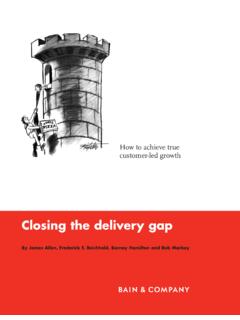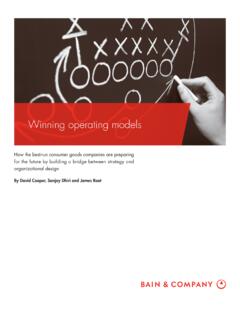Transcription of The value of Big Data: How analytics differentiates winners
1 the value of Big data : How analytics differentiates winnersIn our survey, only 4% of companies said they had the right people, tools, data and intent to draw meaningful insights from that data and to act on Rasmus Wegener and Velu SinhaRasmus Wegener is a partner with Bain & Company in Atlanta, and Velu Sinha is a Bain partner in Silicon Valley. Both work with the fi rm s Global Technology practice. The authors would like to acknowledge the contributions of James Dillard, a consultant with Bain & Company in 2013 Bain & Company, Inc. All rights value of Big data : How analytics differentiates winners1 Big data is quickly becoming a critically important driver of business success across sectors, but many executives say they don t think their companies are equipped to make the most of it.
2 Bain & Company surveyed executives at more than 400 companies around the world, most with revenues of more than $1 billion. We asked them about their data and analytics capabilities and about their decision-making speed and effectiveness. The results were surprising: We found that only 4% of companies are really good at analytics , an elite group that puts into play the right people, tools, data and intentional focus. These are the companies that are already using analytics insights to change the way they operate or to improve their products and services. And the difference is already visible. These companies are: Twice as likely to be in the top quartile of financial performance within their industries Three times more likely to execute decisions as intended Five times more likely to make decisions fasterAs we describe in a companion brief, Big data : The organizational challenge, achieving competency in Big data is a three-part process that requires setting the ambition, building up the analytics capability and organizing your company to make the most of the opportunity.
3 This brief looks more closely at the second step building up the analytics capability to see how leaders use Big data to get ahead. data , tools, people and intentLeaders build up their analytics capabilities by investing in four things: data -savvy people, quality data , state-of-the-art tools, and processes and incentives that support analytical decision making (see Figure 1). About a third of companies don t do any of these well, and many of the rest excel in only one or two areas. But to build a high-performing analytics machine, you need to do all four well. Success in each capability depends on strength in the others. data .
4 Companies need a strategic plan for collect-ing and organizing data , one that aligns with the business strategy of how they will use that data to Figure 1: Four elements are important for developing advanced analytical capabilitiesToolsPeopleIntentDataQuality , consistent data stored in a manner that is easy to access Only 19% of companies surveyed have high quality, consistent data in their organizationsState-of-the-art tools like unstructured databases, scale-out compute clusters and heuristic instrumentation 38% of companies surveyed are using state-of-the-art analytics toolsMix of data science, business acumen and technical expertise 36% of companies surveyed have a dedicated data -insights teamResolving to be data driven.
5 Creating structures, processes and incentives to support analytical decision making 23% of companies surveyed have clear strategies for using analytics effectivelySource: Bain research, n=40921 FourelFomnotsaoirprfodmvorgrecpsybo2snnF 3 FgpsrpFbovsggF3b People. In our survey, 56% of executives said their companies lacked the capabilities to develop deep, data -driven insights. Most agreed they were not up to the challenges of identifying and prioritizing what types of insights would be most relevant to the business. Successful analytics teams build those capabilities by blending data , technical and business talent. Think of a band as the model: a team with different but overlapping skills that knows how to effectively and efficiently communicate and collab-orate.
6 Successful Big data and analytics efforts need: data scientists, who provide expertise in statistics, correlations and quality; Business analysts, who identify and prioritize the problems worth solving and the business relevance of data anomalies and patterns iden-tified by the data scientists; Technical specialists, who help manage the hardware and software solutions needed to collect, clean and process the data ; Organizational intent. Leading companies embed analytics into their organizations by resolving to be data driven and defining what they hope to accomplish through their use of Big data . The CEO and top leadership team need to describe how analytics will shape the business s performance, whether by improving existing products and services, optimizing internal processes, building new products or service offerings, or transforming business models.
7 Top-performing organizations do this well, often building their organizations around data and a commitment to make data -driven decisions (see Figure 2). Nest is a good example of a company that built into its business model the intent to learn from advanced analytics and Big data . Other companies offer their customers the ability to remotely control their home thermostats through a Web interface or their smart-create value . In our analytics survey, 56% of the companies didn t have the right systems to capture the data they needed or weren t collecting useful data , and 66% lacked the right technology to store and access data . A good data policy identifies relevant data sources and builds a data view on the business in order to and this is the critical part differen-tiate your company s analytics capabilities and per-spective from competitors.
8 A critical aspect of good data policy is to focus on identifying relevant sources of data . For example, capturing all queries made on the company website or from customer support calls, emails or chat lines, regardless of their outcome, may have significant value in identifying emerging trends; however, keeping detailed logs of requests that were easily handled might be less valuable. Tools. Aim high in your aspirations of what s pos-sible. Advanced analytics and Big data tools are developing so rapidly that they re likely to help you get to potential insights and statistical novelties in ways that were not possible even as recently as a year ago.
9 Tools and platforms like Hadoop, HPCC and NoSQL are rapidly emerging and evolving to address analytics opportunities, as is the rich eco-system of mature analytics , visualization and data management. Today, these tools are available from a wide range of vendors and an even larger community of open-source developers. Still, and somewhat surprising, in our survey, only 38% of companies said they were using any of companies embed analytics into their organizations by resolving to be data driven and defining what they hope to accomplish through their use of Big data . The CEO and top leadership team need to describe how analytics will shape the business s value of Big data : How analytics differentiates winners3phones.
10 Nest goes further, crowdsourcing intelligence about when and how customers adjust their thermo-stats to keep their homes comfortable. Nest gathers that information in the cloud, and by correlating it with weather, location, type of home and when people adjust their thermostats, the company can anticipate and control the settings to create a more comfortable environment in their customers to excellence in each of these four categories can require dramatic changes, significant investment and occasionally a change in leadership. But it s no good focusing on one of these four areas without the other three. Tools won t help if the data is of poor quality, and talent will walk if the company isn t committed to benefiting from the insights.







